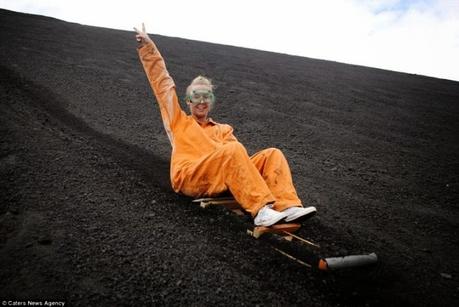 It is not perhaps the first thing you would think to
do when encountering an incredibly active volcano. But the bizarre sport of
'volcano boarding' has certainly taken off in Nicaragua, where travellers join
$31 (£20) tours so they can enjoy sliding down enormous ashy slopes. The
thrillseekers career down the 2,382ft peak reaching speeds of 60 miles per
hour, wearing nothing more than a jumpsuit and goggles for protection and zip
down on plywood boards.
The terrifying tours see about 30 travellers at a time
hike up the volcano so they can board back down it at breakneck speeds. Travellers
speed down the huge ash slopes in just 20 seconds, wearing just a boiler suit
and goggles for protection – this bizarre sport takes place on the active Cerro
Negro volcano in Nicaragua and sees adventurers hike to the top of the then sit
on a plywood board and sledge down the ash. The races down the slopes don't
always go to plan, but organisers say the worst injury suffered has been a
broken ankle.
It is not perhaps the first thing you would think to
do when encountering an incredibly active volcano. But the bizarre sport of
'volcano boarding' has certainly taken off in Nicaragua, where travellers join
$31 (£20) tours so they can enjoy sliding down enormous ashy slopes. The
thrillseekers career down the 2,382ft peak reaching speeds of 60 miles per
hour, wearing nothing more than a jumpsuit and goggles for protection and zip
down on plywood boards.
The terrifying tours see about 30 travellers at a time
hike up the volcano so they can board back down it at breakneck speeds. Travellers
speed down the huge ash slopes in just 20 seconds, wearing just a boiler suit
and goggles for protection – this bizarre sport takes place on the active Cerro
Negro volcano in Nicaragua and sees adventurers hike to the top of the then sit
on a plywood board and sledge down the ash. The races down the slopes don't
always go to plan, but organisers say the worst injury suffered has been a
broken ankle.
 To those engaged, Volcano Boarding is a unique extreme
sport and there is no other place on earth you can slide down an active
volcano, so the fact that it's an exclusive spot makes it quite special. It is
classified as a cinder cone volcano, the most common on the planet, which spews
lava fountains through the top or through vents at the base. Cinder cone volcanoes normally have a 60-year
lifespan, but Cerro Negor is 120 years old and has erupted 23 times instead of
the average one. The Cerro Negro volcano
is likely to erupt at any time and its last eruption took place in 1999. It is
stated that when the Cerro Negro - which
was conceived in 1850 - erupted in 1992, it covered the nearby city of Leon in
8cm of volcanic ash.
Cerro
Negro in English means 'black hill' and takes its name from the dense black ash
that coats the slopes ~ strange are the ways of people
With regards – S. Sampathkumar
18th Feb 2015.
To those engaged, Volcano Boarding is a unique extreme
sport and there is no other place on earth you can slide down an active
volcano, so the fact that it's an exclusive spot makes it quite special. It is
classified as a cinder cone volcano, the most common on the planet, which spews
lava fountains through the top or through vents at the base. Cinder cone volcanoes normally have a 60-year
lifespan, but Cerro Negor is 120 years old and has erupted 23 times instead of
the average one. The Cerro Negro volcano
is likely to erupt at any time and its last eruption took place in 1999. It is
stated that when the Cerro Negro - which
was conceived in 1850 - erupted in 1992, it covered the nearby city of Leon in
8cm of volcanic ash.
Cerro
Negro in English means 'black hill' and takes its name from the dense black ash
that coats the slopes ~ strange are the ways of people
With regards – S. Sampathkumar
18th Feb 2015.

